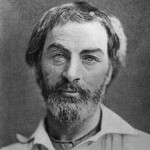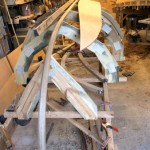“And I know that the spirit of God is the eldest brother of my own,
And that all the men ever born are also my brothers . . . . and the women my sisters
and lovers,
And that a kelson of the creation is love; ” (Whitman 83-86).
1. a. A line of timber placed inside a ship along the floor-timbers and parallel with the keel, to which it is bolted, so as to fasten the floor-timbers and the keel together; a similar bar or combination of iron plates in iron vessels.
b. With qualifying terms: assistant kelson or keelson = side-kelson; bilge-k., an additional strengthening beam placed fore-and-aft in the bilge of a vessel, parallel to the kelson; boiler-k., a bilge- or cross-kelson supporting the boilers of a steamer (Hamersly Naval Encycl. 1881); box-k., a kelson whose section is box-shaped; cross-k., a beam placed across the kelson to support the boilers or engines of a steamer (Webster, 1864); engine-k., a side- or cross-kelson supporting the engines in a steamer (Hamersly, 1881); false k., an additional beam placed longitudinally above the kelson in order to strengthen it
1942 R. H. LONGE in R. A. Beaumont Aeronaut. Engin. xviii. 486/1 The keelson..is the backbone of the hull [of a flying-boat], and runs the full length of the hull, from the stem or bow, to the stern-post.
This word, kelson, what does it mean, I wondered to myself as I read “Song of Myself” for the very first time a few weeks ago. I wondered, though I admittedly failed (then, anyway) to consult a dictionary or even steal a quick peak at Wikipedia’s definition. I was giving special attention to this stanza because it was one (among several others) that I was considering to use with my image gloss at the time. The three lines preceding the line in which the esoteric “kelson” appeared were particularly interesting to me, in a spiritual way; I mean, specifically the talk about all men being my brothers all all women my sisters, God, creation, love… these lines appealed to my theosophical&mystical tendencies. I felt that, in these lines, Whitman was professing a belief in concepts like The Universal Brotherhood of Man and man’s relationship with the divine-and God’s relationship to the creation and men, for that matter… Ahh, but kelson… what did it mean to say that “a kelson of the creation is love?” as Whitman sings. Well, as it turns out, kelson, refers to a kind of foundational “backbone” of a ship, a “line of timber,” a “strengthening beam…” I discovered that the kelson provided longitudinal support as well as base-support (parallel with the keel). Furthermore, the essential function of a kelson appears to be to bind the longitudinal keel with the wooden boards of the boat-> the outer, transverse, shell, if you will. When applying these details to the line of the poem in which the term “kelson” appears, the formerly obscured meaning of the line comes to light. “A kelson of the creation is love.” If we are to accept God as the catalyst/initiator of The Creation (as Whitman indirectly does) then “a kelson,” or foundational backbone/ connecting beam, of His Creation is love. Said in another way, the answer to the question of Creation, the beam which supports, explains, and motivates it is in fact, Love, or specifically, God’s love for men.
**Update: After reading some of James E. Miller Jr.’s “Song of Myself as Inverted Mystical Experience,” my initial intimations seem to be confirmed (or, at least Miller’s on my side ;)) ! Miller’s fascinating interpretation classifies the poem into 5 phases of a Mystical Experience, from the awakening of self to union (with the Transcendent) and finally, emergence from the mystical state. Towards the end of the poem, Whitman again makes mention of “the creation,” in the line “To it the creation is the friend whose embracing awakes me.” Miller seems to suggest that Whitman, upon awakening from his transcendent/mystical experience, struggles and ultimately cannot put into words or define the exact nature of his experience (or of his newly-acquired transcendent wisdom/understanding). However, I think there is a clue in the earlier lines where “the creation” is first mentioned. As we know, it is God who is responsible for “the Creation” and so, if we replace Whitman’s inexpressible “It” with what God is-namely, the Infinite, the Ultimate, the inexhaustible- then we may have a clearer idea of what Whitman came to understand as a result of his mystical experience.
Works Cited
“Kelson” Oxford English Dictionary. Oxford University Press, 2009 <http://dictionary.oed.com.proxy.libraries.rutgers.edu/>.
Miller Jr., James E. A Critical Guide to Leaves of Grass. Chicago: The University of Chicago Press, 1957.
Whitman, Walt. “Song of Myself (1855).” Whitman Poetry & Prose. Library of America, 1996. 59.
Image 1: Composition Gallery Walt Whitman Photograph <http://www.compositiongallery.com/show/image/48/large/walt-whitman-photograph.jpg>.
Image 2: “Elfyn Photograph” Tom Regan (Boatbuilder, Owner Grapevine Point Boat Works) <http://www.grapeviewpointboatworks.com/images/elfyn/garboard.jpg>.



Excellent explication of a term and poem, and great use of sources. Thanks for pointing attention to James Miller’s essay. Whitman’s marine and navigational imagery is interesting in and of itself. See, for example, his famous “Crossing Brooklyn Ferry.” The Camden riverfront was a bustling with during Whitman’s time, with boats sailing up the Chesapeake to Philadelphia and Camden and farther north.